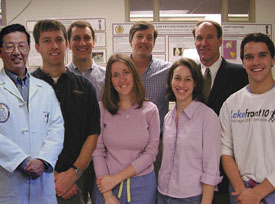PCL Kinematics Laboratory
ACL Group | MCL Group
Shoulder Group | Tendinitis | Hand and Upper Extremity Group
Team Members:
|
 |
Research Objectives:
Under the direction of Dr. Harner, the PCL group has continued its investigation of the biomechanics of the PCL and PCL replacement grafts. The research is motivated by the poor long-term prognosis of patients with PCL injuries. PCL deficiency has been associated with progressive instability and the early onset of arthritis, while PCL reconstructive surgery has failed to completely restore normal knee laxity. These variable outcomes of PCL reconstructions have been attributed by some to the high incidence of associated injuries to the posterolateral structures (PLS) of the knee. It is the objective of the PCL group to investigate the biomechanics of the PCL and its associated structures, as well as PCL replacement grafts, with the long term goal of identifying procedures which will best replace the function of the intact PCL in the PCL-injured knee.
Research Projects:
1. Grant:
|
2. Ongoing Projects:
Tibial Inlay Project: The objective of this study was to compare to PCL reconstruction techniques, the inlay technique and the single bundle trans-tibial tunnel technique.
Double Bundle/PLS Reconstruction Project: Evaluation of the effects of PLS reconstruction in the PCL reconstructed knee. Because PLS-deficiency has been shown to increase in situ forces in the PCL replacement graft, the effects of PLS reconstruction on in situ forces in the PCL and its contribution to knee kinematics, will be determined in response to anterior-posterior tibial loads, and internal-external torques. The effects of PLS-deficiency on the in situ forces in the PCL reconstruction, will also be assessed.
